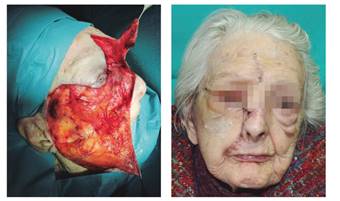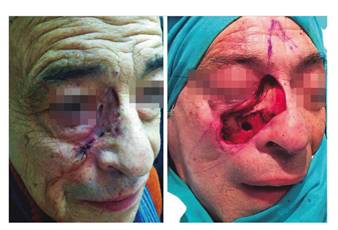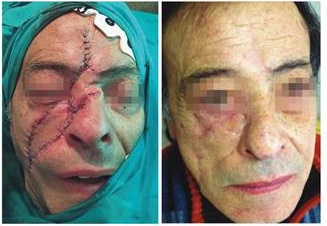INTRODUCTION
The multiple aesthetic subunits of the face are defined by the natural mobility of the facial muscles, as well as by the skin colour, texture, thickness, facial planes, concavity, and convexity1,2,3,4,5,6. The geography of the central face includes many anatomic units and its component subunits, which are essential to define an individual face4. Defects affecting more than one facial subunit are quite common and may represent a reconstructive challenge, but there is not a unified approach to repair them4.
Nasal sidewall and medial cheek are two adjacent subunits with specific differences between them. Trying to restore a composite defect involving these subunits with a single flap may be the first instinct, but this is rarely the best option1,2,3,4,5,6. Doing so can lead us to obtain a bulky flap which has no similarity to the skin of the defect's site. Considering this, the reconstruction of a defect affecting nasal sidewall and medial cheek subunits requires a carefully planned reconstruction of each of the subunits.
We report two cases to show the outcomes after reconstructing composite facial defects affecting both nasal sidewall and medial cheek by using different flaps for each subunit. Informed consent of each patient was obtained.
CLINICAL CASES
The first case presented is a 90-year-old woman who presented with a big, ulcerated lesion affecting both the nasal sidewall and the medial cheek, and even the inferior eyelid of the right eye (Figure 1). The histological analysis confirmed a squamous cell carcinoma moderately differentiated. An enhanced cervicofacial CT scan was performed to determine extension and discard cervical disease. The CT scan did not show cervicofacial nodal involvement and then surgery was performed.

Figure 1. A big, ulcerated lesion affecting both the nasal sidewall and the medial cheek, and even the inferior eyelid of the right eye (left). After the extirpation, we faced to a big cutaneous defect affecting both the nasal sidewall and medial cheek. Design of the flaps is shown (right).
A conservative approach was decided, preserving the right eye due to the age, comorbidities, and fragility of the patient. The extirpation of the tumour resulted in a big cutaneous defect affecting the right nasal sidewall, the right medial cheek, and the inferior eyelid of the right eye (Figure 1). An inverse facial advancement flap was harvested, elevated and advanced to cover the cheek and the inferior eyelid, and a glabellar flap was harvested, elevated, and rotated to cover the nasal defect (Figure 2). A lateral and medial canthopexy were also performed.

Figure 2. Harvesting of an inverse facial advancement for the cheek and the lower eyelid and a glabellar flap for the nose (left). Results after 1 week (right).
The surgical results after one week are shown (Figure 2). The follow up after 6 months showed good cosmetic and functional results, as the patient preserved a good eyelid competence despite the small right eyelid retraction. No adjuvant therapy was considered. No revision surgery was needed.
The second case is a 70 year-old-man who presented a recurrence of a basal cell skin cancer previously irradiated. The lesion was ill defined and affected the medial cheek and the nasal sidewall (Figure 3).

Figure 3. Recurrence of a basal cell skin cancer previously irradiated, affecting both medial cheek and nasal sidewall (left). Defect after removal of the skin tumour and the anterior wall of the maxillary sinus (right).
The reconstruction of this defect presented a challenge due to the extension, location, and fragility of the irradiated soft tissues. The CT scan showed invasion of the anterior wall of the maxillary sinus. No nodal involvement was found.
The surgical technique consisted in the tumour extirpation, including the anterior wall of the maxillary sinus (Figure 3). For the reconstruction, a glabellar flap was harvested, elevated, and rotated to cover the nasal defect, and a V-Y advancement flap of the right nasogenian area to cover the cheek (Figure 4). No reconstruction of the anterior sinus wall was performed, but in the postoperative period some depression of the area was detected and an infiltration of autologous fat from the abdominal area was performed. After 6 months he presented good cosmetic and functional results (Figure 4). He remained free of disease after 2 years of follow up.
DISCUSSION
Aesthetic principles and donor-site morbidity should be considered in the reconstruction of facial defects1,2. This is particularly relevant in composite defects involving nasal sidewall and medial cheek. The nasal sidewall is a combination of convex and concave elements extending laterally from the dorsum to the junction of the nose with the medial cheek. The medial cheek joins the nose in an advancing slope into the nasal sidewall. Nasal skin differs histologically from every facial subunit, and specially from the cheek, as it has a significantly thicker dermal tissue and a higher amount of sebaceous glands7. Nasal skin is thin and limp in the rhynion area and becomes thicker caudally, as it adheres to the deep planes. When defects of the medial cheek extend onto the nasal sidewall, a single posteriorly or anteriorly based rotation advancement flap may lead to blunting of the nasofacial sulcus2,4,5. For this reason it may be necessary to repair the nasal portion with a separate flap. These rules of central subunit reconstruction ensure similar skin quality and scars at the periphery of subunits so that they are hidden in the joins between them. Furthermore, this approach draws on centripetal wound contraction to establish a convex subunit contour. Our aim in the present manuscript was to restore the normal facial appearance by using two different flaps to reconstruct these defects. The glabellar flap is an option for nasal reconstruction, broadly described in the literature8, which offers excellent colour, texture, and volume match to restore nasal sidewall defects. The restoration of the medial cheek can be achieved by many different reconstruction techniques. Bernstein9 performs a two-flap technique to addresses a composite medial cheek and nasal sidewall defect by removing a small Burow's triangle at the ala-cheek junction and then advancing the cheek to the nasofacial sulcus, and a transposition nasal flap to cover the nasal defect. Kim et al.10 performs a cheek advancement with two Burrow's triangles and covers the nasal defect with a skin graft. Suárez et al.11 performs a bilateral nasolabial V-Y island flaps combined with a glabella V-Y island flap to complete the 'like-for-like' subunit reconstruction after excision of a disfiguring xantelasma that extended from canthus to canthus through the nasal bridge. In the series of Rohrich et al.12 a complex wound of nasal dorsum, sidewalls, medial cheeks, ala, tip, and partial columella is presented. They addressed the medial cheek defects with bilateral cheek advancement flaps and the dorsum, sidewalls, ala, tip, and anterior columellar defects were covered with a large forehead flap. We believe that preserving or recreating the nasofacial sulcus as an essential feature of the normal-appearing nose is mandatory to achieve a good cosmetic result. Rossi et al.(13 develop a single flap reconstruction with an advancement cheek flap for the reconstruction of postoncological extended nasal sidewall defects, with good aesthetic results. Nevertheless, in our experience this type of single flap reconstruction for this type of defects leads to better results in some selected patients with soft tissue excess at the level of the nasofacial union.
This study has some limitations, as the ideas are based on theoretical concepts, with the preliminary experience of some cases, obtaining good results.
In our experience, the use of separate flaps to reconstruct these composite facial defects allowed to obtain very pleasant like with like results.















